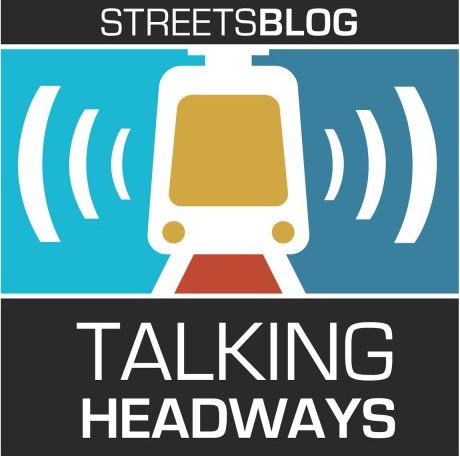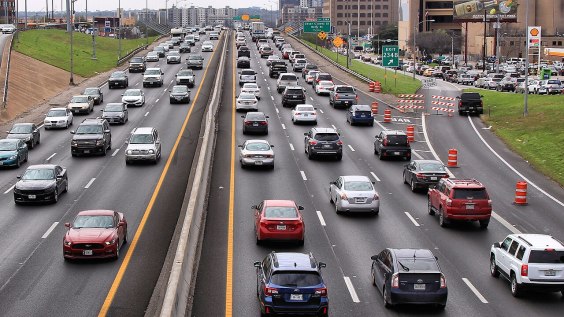This week, we’re joined by Dr. Megan Ryerson, UPS Chair of Transportation at the University of Pennsylvania’s Weitzman School of Design. In this special episode, Ryerson talks about her research on cognitive workload, measuring the stress of cyclists at intersections, transportation during the pandemic, the uneven power dynamics (cars vs. everyone else) in traffic safety, and how the inability to navigate our streets are a form of discrimination.
For those of you who get your news through your eyes and not your ears, there's an edited transcript below the audio player. If you want a full unedited transcript (with some typos!), click here. If you want to listen, here you go:
Here's the partial transcript:
Jeff Wood: Let's talk about drivers — and how a driver's response sitting inside of a two- or four-ton vehicle differs from, say, the cyclist and pedestrian response. I know that you haven’t done this research yet, but do you think it would be a different response and are we over-designing roads for that car response versus the more vulnerable users' response.
Dr. Megan Ryerson: Our roadway system and all of the guidelines for how we design roads, are based on driver workload and driver line of sight, right? And so driving simulators and eye-tracking glasses etc are a very common way that we approach road design and road safety. And I think even the Federal Highway Administration and universities have driving simulators and study these in-vehicle experience.
Like you said, when you’re driving a two-ton vehicle, your mistakes have significant implications. And you know, when you’re driving a simulator, they don’t, and you can try out other things. All of our roadway design guidance is based on driver line of sight and what a driver can see. And really all about the driver experience. And so if we’re focused on the driver experience, then absolutely we're over-designing roads to make sure drivers are comfortable and their workload isn't too high, right?
What makes your workload high? Narrow lanes, right? A lots of different pedestrian, cyclists, and so on. And it makes you go a lot slower. Right? And, you know, when we focus on things like minimizing driver workload, we have wider lanes, right, or no cyclists, or cyclists allowed only on the side or very controlled access for pedestrians and so on. And it’s led to this roadway system that focuses on increasing the driver’s ability to see the cyclist and that’s it — the design of this bike lane helps the drivers see the cyclist like this, right?
So no, it’s not about the cyclist’s experience. It’s about the driver not hitting into the cyclist because they can see them. And that’s certainly an important aspect of safety. I certainly want that to be considered, but it shouldn’t be the only thing that is considered, right? Because then automatically the cyclists are the vulnerable ones that need to be responsible for their own safety. And we just need to make sure the driver can see the cyclist rather than saying, "Well, if the roads are more narrow and the drivers will go slower, it will naturally reduce our likelihood of an accident" and so on.
Wood: It’s so interesting because you kind of have to put yourself in the shoes of the vehicle or mode of travel. So if you’re in a car, you want to increase the amount of workload because you want people to slow down. I mean, we know this from narrow streets, the way, you know, in the older parts of Philadelphia, I’m sure there’s many cobblestones and other places and you know, that people go slow. Whereas cyclists, you’re trying to kind of reduce the workload because you are trying to be protective, but also have safety involved. And that changes the paradigm of how we design streets and roads as you mentioned, how would you kind of redesign a safety agenda around those specific ideas, such that we’re actually focused on the results of better safety looking at all those variables, rather than just, like you said, the line of sight for automobile users. What would be the first thing that you did or what would be a safety agenda that you would design using this information that you have?
Ryerson: The first order of business would be including workload and stress maps for pedestrians and cyclists, in addition to crash maps and really thinking about what are the segments of roadways where non-motorized modes (cyclists, pedestrians) are having their most stressful moments, and layer that on top. I really like what you said about how we want to decrease workload for cyclists and pedestrians, and increasing the workload for drivers because then they pay more attention.
So if we have maps of high workload for non-motorized users, for pedestrians and cyclists, can we then look at those segments of roads and see how we can increase the workload for drivers? Can we make the lanes narrower here? Can we add protection to this bike lane and, you know, physically restricted area that sends that signal to drivers to be more careful. Can we, you know, bump out the curves, all of the things that are in the NACTO guide that slow down traffic because they cause the driver to have to be more aware, right?
So it’s really a linking of where are the locations that are inciting stress and workload for our most vulnerable users. And how can we design interventions that reduce their workload. And part of reducing that workload is significantly slowing drivers speed and increasing driver awareness. When I see a driver on their cell phone, which I live in Philadelphia is nine out of 10 drivers. I think about workload a lot, because I think this driving task is so easy for you, that you can look at your phone and it shouldn’t be, it should be more aware for sure.
But if they’re only concerned about their own personal safety, well, they feel like they can, this is an extra thing they can add into their workload mix. That’s a real problem, right? That they have that much mental capacity while they’re driving to look at a phone. And so we need to think about how are we designing our roads, such that they command the attention of the drivers, because they’re not going to see that cyclist, even if the site distance is good, if they’re on their phone, because it’s so easy to drive down this road.






